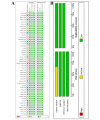Machine Learning Models for Blood Glucose Level Prediction in Patients With Diabetes Mellitus: Systematic Review and Network Meta-Analysis
- PMID: 37983072
- PMCID: PMC10696506
- DOI: 10.2196/47833
Machine Learning Models for Blood Glucose Level Prediction in Patients With Diabetes Mellitus: Systematic Review and Network Meta-Analysis
Abstract
Background: Machine learning (ML) models provide more choices to patients with diabetes mellitus (DM) to more properly manage blood glucose (BG) levels. However, because of numerous types of ML algorithms, choosing an appropriate model is vitally important.
Objective: In a systematic review and network meta-analysis, this study aimed to comprehensively assess the performance of ML models in predicting BG levels. In addition, we assessed ML models used to detect and predict adverse BG (hypoglycemia) events by calculating pooled estimates of sensitivity and specificity.
Methods: PubMed, Embase, Web of Science, and Institute of Electrical and Electronics Engineers Explore databases were systematically searched for studies on predicting BG levels and predicting or detecting adverse BG events using ML models, from inception to November 2022. Studies that assessed the performance of different ML models in predicting or detecting BG levels or adverse BG events of patients with DM were included. Studies with no derivation or performance metrics of ML models were excluded. The Quality Assessment of Diagnostic Accuracy Studies tool was applied to assess the quality of included studies. Primary outcomes were the relative ranking of ML models for predicting BG levels in different prediction horizons (PHs) and pooled estimates of the sensitivity and specificity of ML models in detecting or predicting adverse BG events.
Results: In total, 46 eligible studies were included for meta-analysis. Regarding ML models for predicting BG levels, the means of the absolute root mean square error (RMSE) in a PH of 15, 30, 45, and 60 minutes were 18.88 (SD 19.71), 21.40 (SD 12.56), 21.27 (SD 5.17), and 30.01 (SD 7.23) mg/dL, respectively. The neural network model (NNM) showed the highest relative performance in different PHs. Furthermore, the pooled estimates of the positive likelihood ratio and the negative likelihood ratio of ML models were 8.3 (95% CI 5.7-12.0) and 0.31 (95% CI 0.22-0.44), respectively, for predicting hypoglycemia and 2.4 (95% CI 1.6-3.7) and 0.37 (95% CI 0.29-0.46), respectively, for detecting hypoglycemia.
Conclusions: Statistically significant high heterogeneity was detected in all subgroups, with different sources of heterogeneity. For predicting precise BG levels, the RMSE increases with a rise in the PH, and the NNM shows the highest relative performance among all the ML models. Meanwhile, current ML models have sufficient ability to predict adverse BG events, while their ability to detect adverse BG events needs to be enhanced.
Trial registration: PROSPERO CRD42022375250; https://www.crd.york.ac.uk/prospero/display_record.php?RecordID=375250.
Keywords: blood glucose; blood glucose management; diabetes; hypoglycemia; machine learning.
©Kui Liu, Linyi Li, Yifei Ma, Jun Jiang, Zhenhua Liu, Zichen Ye, Shuang Liu, Chen Pu, Changsheng Chen, Yi Wan. Originally published in JMIR Medical Informatics (https://medinform.jmir.org), 20.11.2023.
Conflict of interest statement
Conflicts of Interest: None declared.
Figures










References
-
- Saeedi P, Petersohn I, Salpea P, Malanda B, Karuranga S, Unwin N, Colagiuri S, Guariguata L, Motala AA, Ogurtsova K, Shaw JE, Bright D, Williams R, IDF Diabetes Atlas Committee Global and regional diabetes prevalence estimates for 2019 and projections for 2030 and 2045: results from the International Diabetes Federation Diabetes Atlas, 9 edition. Diabetes Res Clin Pract. 2019 Nov;157:107843. doi: 10.1016/j.diabres.2019.107843.S0168-8227(19)31230-6 - DOI - PubMed
-
- BMC Medicine Diabetes education for better personalized management in pediatric patients. BMC Med. 2023 Jan 24;21(1):30. doi: 10.1186/s12916-022-02709-2. https://bmcmedicine.biomedcentral.com/articles/10.1186/s12916-022-02709-2 10.1186/s12916-022-02709-2 - DOI - DOI - PMC - PubMed
-
- Chen D, Wang M, Shang X, Liu X, Liu X, Ge T, Ren Q, Ren X, Song X, Xu H, Sun M, Zhou H, Chang B. Development and validation of an incidence risk prediction model for early foot ulcer in diabetes based on a high evidence systematic review and meta-analysis. Diabetes Res Clin Pract. 2021 Oct;180:109040. doi: 10.1016/j.diabres.2021.109040.S0168-8227(21)00399-5 - DOI - PubMed
-
- Li Y, Su X, Ye Q, Guo X, Xu B, Guan T, Chen A. The predictive value of diabetic retinopathy on subsequent diabetic nephropathy in patients with type 2 diabetes: a systematic review and meta-analysis of prospective studies. Ren Fail. 2021 Dec;43(1):231–240. doi: 10.1080/0886022X.2020.1866010. https://europepmc.org/abstract/MED/33478336 - DOI - PMC - PubMed
LinkOut - more resources
Full Text Sources

